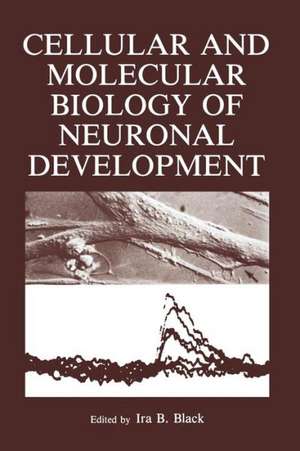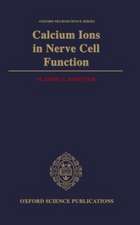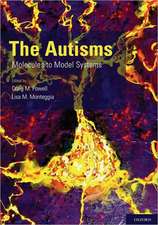Cellular and Molecular Biology of Neuronal Development
Autor Ira Blacken Limba Engleză Paperback – oct 2011
Preț: 393.74 lei
Nou
Puncte Express: 591
Preț estimativ în valută:
75.35€ • 81.82$ • 63.29£
75.35€ • 81.82$ • 63.29£
Carte tipărită la comandă
Livrare economică 23 aprilie-07 mai
Preluare comenzi: 021 569.72.76
Specificații
ISBN-13: 9781461296867
ISBN-10: 1461296862
Pagini: 392
Ilustrații: XXVI, 363 p. 148 illus.
Dimensiuni: 155 x 235 x 21 mm
Greutate: 0.55 kg
Ediția:1984
Editura: Springer Us
Colecția Springer
Locul publicării:New York, NY, United States
ISBN-10: 1461296862
Pagini: 392
Ilustrații: XXVI, 363 p. 148 illus.
Dimensiuni: 155 x 235 x 21 mm
Greutate: 0.55 kg
Ediția:1984
Editura: Springer Us
Colecția Springer
Locul publicării:New York, NY, United States
Public țintă
ResearchCuprins
I. Embryogenesis and Morphogenesis of the Nervous System.- 1 A Model for Cell Line Divergence in the Ontogeny of the Peripheral Nervous System.- 2 Emergence of Neuronal and Glial Cell Lineages in Primate Brain.- 3 Heterogeneity in Neural Crest Cell Populations.- 4 The First Growth Cones in the Central Nervous System of the Grasshopper Embryo.- II. Developmental Expression of Neuraonal Phenotypic Characters.- 5 Surface-Bound and Released Neuronal Glycoconjugates.- 6 The Differentiation of Membrane Properties of Spinal Neurons.- 7 The Accumulation of Acetylcholine Receptors at Nerve-Muscle Synapses in Culture.- 8 Transmitter Phenotypic Plasticity in Developing and Mature Neurons in Vivo.- III. Nerve Growth Factor as a Model Growth Factor.- 9 Mechanisms of the Promotion of Neurite Outgrowth by Nerve Growth Factor.- 10 Cultured Sympathetic Neurons in the Study of Nerve Growth Factor Action.- 11 Guanethidine-Induced Destruction of Sympathetic Neurons: An Autoimmune “Disease” Prevented by Nerve Growth Factor.- 12 Enhanced Dependence of Fetal Mouse Neurons on Trophic Fators after Taxol Exposure in Organotypic Cultures.- 13 The Interaction of Nerve Growth Factor with Its Specific Receptors.- IV. New Neuronal Growth Factors.- 14 Multiple Sites for the Regulation of Neurite Outgrowth.- 15 Nerve Growth Factors in Chick and Rat Tissues.- 16 Macromolecular Factors Involved in the Regulation of the Survival and Differentiation of Peripheral Sensory and Sympathetic Neurons.- 17 Trophic and Neurite-Promoting Factors for Cholinergic Neurons.- V. Molecular Biology of Neural Development and Function.- 18 Expression of Opioid Peptide Genes in Different Species.- 19 Isolation and Characterization of DNA Sequences Coding for Mouse and Human ß-Nerve Growth Factor.- 20 Linkage Analysis inFamilial Dysautonomia Using Variations in DNA Sequence in the ß Nerve Growth Factor Gene Region: A Beginning.- VI. Diseases of Development.- 21 Familial Dysautonomia and Other Congenital Sensory and Autonomic Neuropathies.- 22 Developmental Neurobiology of Human Diseases: Familial Dysautonomia and Related Disorders.















